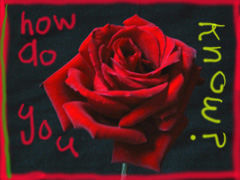
Yesterday morning, Liam Rector, the director of Bennington College’s MFA Writing program, sent out links to this article to those he thought might be interested, myself included. It’s a thoughtful and sobering piece from Higher Ed Magazine, that talks about what happens when creative writing teachers come across unusually violent content in the writing of their students. It pertains, obviously, to the writing of Cho Seung-Hui, the Virginia Tech shooter, who was also an English major, but it goes much further, into the issue in general. It’s called, “When Creative Writing Provides a Clue,” and it’s a worthwhile read, comments included.

So, once a problem is identified, what can be done?
Link: THE SCHOOL FAILED THE STUDENTS
Did you know that both houses of the Virginia legislature unanimously passed legislation within the past year or so that barred Virginia colleges and universities from expelling a student on the basis of mental instability? Virginia colleges and universities were also banned from suspending or expelling a student because of an attempted suicide or the expression of suicidal thoughts?
Hmmm. Let me try that link again.
THE SCHOOL FAILED THE STUDENTS
Of course the legislature also failed the students by not requiring background checks for the purchase of a firearm.We can have a nice debate about privacy rights and forced medication but this guy had been to mental health, he had been put on suicide watch. An, yet, he walked into a shop and purchased a Glock and that was that. So tell me, what part of “A Well Regulated Militia” don’t you understand?
Great piece by a columnist in the NY DAILY NEWS (where 40% of the guns used in crime come from the Commonwealth of Virginia): “Hey Virginia, Still like your Gun Laws Today?”
There is very little left in the delivery of American education that doesn’t carry a damned if you do – damned if you don’t element. It doesn’t matter at what level you look, K – PhD, there is a hooked barb if a teacher, professor, or school/college/university administrator tries to intervene on behalf of a student.
I left behind my job as a teacher in the public schools back in the 70s when simultaneous cases were being heard in California and New York. In one instance a school was being sued for holding a student back, and another was being sued for promoting a student to the next grade level. It was clear then what would evolve were layers of if-buts that would make it almost impossible to discern what an appropriate action would be for any given academic instance. Layer over the top of that ADA rulings, the Tarasoff decision, and FERPA and you have a situation in which it’s profoundly hard to come to any decision without an army of lawyers and a well endowed liability fund.
I’ve had only brief brushes with being in the front of a college classroom, by design. But even I’ve had submitted student writings that made my guts clutch, and it wasn’t a creative writing class. I can only imagine what creative writing and composition professors face every day. It’s a wonder they even show up.
Ms. Pokey once wrote:
The decision to legalize abortion in the landmark case of Roe vs. Wade was due to the fact that judges could not answer the question of whether the baby was life or not – the answer was: “we don’t know.â€Â
It is the way of man to have a fast-food mentality – seeking benefit and comfort in the world without hard-work or tears, nor an eternal outlook. It is the way of man to resist gratification delay, seeking his reward immediately. It is the way of man to try to escape the consequences of his own actions. It is man’s way to be self-centered and selfish at the expense of others. Man wants to be served, rather than to serve. And it is the way of man to say: “I think…†rather than inquire.
Abortion recognizes no responsibility to related and affected parties: father, relatives, baby. Abortion shows no mercy to the helpless and innocent child. Abortion is a short-term ‘convenient’ solution for a temporary problem and for temporary, worldly gain and convenience. Abortion is a short-cut from bearing the consequences of our actions. Abortion serves the stronger, not the weaker. Abortion regards ‘self’ above others.
Life involves pain, disappointment, and hard work – no way around it. Terminating a pregnancy may eliminate certain unwanted temporary distress for a woman, but for what gain? At who’s expense?
A life that is dependent upon another for its well-being is deserving of MORE consideration, not less. A mother’s obligation to the child is greater while the baby is in the womb because of its dependency. Once the baby is born and others can reasonably care for it, a mother’s personal obligation actually diminishes.
Even elderly and disabled are dependent upon others, yet we do not consider eliminating them for our convenience to be acceptable. Moral truth is eternal and unchanging, and applies in all circumstances.
Partial birth abortion is no more justifiable morally than early term abortion. Life is life. Actually, because partial birth abortion kills a life that is viable independently of the womb, moments before it is allowed to take a breath, it even violates the original standards for abortion law itself.
Partial birth abortion is never medically necessary for the safety of the mother’s health should the pregnancy pose a threat to her life, because she has already carried the baby to term and live birth is 100% viable if not artificially terminated.
Sorry – Wrong Blog Topic
That’s okay. The irony was worth it.
Great comedic juxtaposition, indeed!